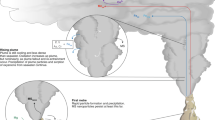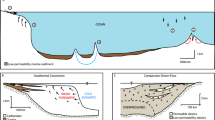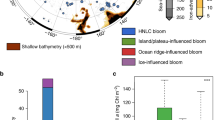Abstract
Hydrothermal venting along mid-ocean ridges exerts an important control on the chemical composition of sea water by serving as a major source or sink for a number of trace elements in the ocean1,2,3. Of these, iron has received considerable attention because of its role as an essential and often limiting nutrient for primary production in regions of the ocean that are of critical importance for the global carbon cycle4. It has been thought that most of the dissolved iron discharged by hydrothermal vents is lost from solution close to ridge-axis sources2,5 and is thus of limited importance for ocean biogeochemistry6. This long-standing view is challenged by recent studies which suggest that stabilization of hydrothermal dissolved iron may facilitate its long-range oceanic transport7,8,9,10. Such transport has been subsequently inferred from spatially limited oceanographic observations11,12,13. Here we report data from the US GEOTRACES Eastern Pacific Zonal Transect (EPZT) that demonstrate lateral transport of hydrothermal dissolved iron, manganese, and aluminium from the southern East Pacific Rise (SEPR) several thousand kilometres westward across the South Pacific Ocean. Dissolved iron exhibits nearly conservative (that is, no loss from solution during transport and mixing) behaviour in this hydrothermal plume, implying a greater longevity in the deep ocean than previously assumed6,14. Based on our observations, we estimate a global hydrothermal dissolved iron input of three to four gigamoles per year to the ocean interior, which is more than fourfold higher than previous estimates7,11,14. Complementary simulations with a global-scale ocean biogeochemical model suggest that the observed transport of hydrothermal dissolved iron requires some means of physicochemical stabilization and indicate that hydrothermally derived iron sustains a large fraction of Southern Ocean export production.
This is a preview of subscription content, access via your institution
Access options
Subscribe to this journal
Receive 51 print issues and online access
$199.00 per year
only $3.90 per issue
Buy this article
- Purchase on Springer Link
- Instant access to full article PDF
Prices may be subject to local taxes which are calculated during checkout




Similar content being viewed by others
References
Von Damm, K. L. Seafloor hydrothermal activity: black smoker chemistry and chimneys. Annu. Rev. Earth Planet. Sci. 18, 173–204 (1990)
German, C. R. & Seyfried, W. E. in Treatise Geochemistry Vol. 8 (eds Holland, H. D. & Turekian, K. K. ) 191–233 (Elsevier, 2014)
Elderfield, H. & Schultz, A. Mid-ocean ridge hydrothermal fluxes and the chemical composition of the ocean. Annu. Rev. Earth Planet. Sci. 24, 191–224 (1996)
Boyd, P. W. & Ellwood, M. J. The biogeochemical cycle of iron in the ocean. Nature Geosci. 3, 675–682 (2010)
Feely, R. A. et al. Hydrothermal plume particles and dissolved phosphate over the superfast-spreading southern East Pacific Rise. Geochim. Cosmochim. Acta 60, 2297–2323 (1996)
Bruland, K. & Lohan, M. in Treatise Geochemistry Vol. 6 (eds Holland, H. D. & Turekian, K. K. ) 23–47 (Elsevier, 2003)
Bennett, S. A. et al. The distribution and stabilisation of dissolved Fe in deep-sea hydrothermal plumes. Earth Planet. Sci. Lett. 270, 157–167 (2008)
Sander, S. G. & Koschinsky, A. Metal flux from hydrothermal vents increased by organic complexation. Nature Geosci. 4, 145–150 (2011)
Yücel, M., Gartman, A., Chan, C. S. & Luther, G. W. Hydrothermal vents as a kinetically stable source of iron-sulphide-bearing nanoparticles to the ocean. Nature Geosci. 4, 367–371 (2011)
Sands, C. M., Connelly, D. P., Statham, P. J. & German, C. R. Size fractionation of trace metals in the Edmond hydrothermal plume, Central Indian Ocean. Earth Planet. Sci. Lett. 319–320, 15–22 (2012)
Fitzsimmons, J. N., Boyle, E. A. & Jenkins, W. J. Distal transport of dissolved hydrothermal iron in the deep South Pacific Ocean. Proc. Natl Acad. Sci. USA 111, 16654–16661 (2014)
Nishioka, J., Obata, H. & Tsumune, D. Evidence of an extensive spread of hydrothermal dissolved iron in the Indian Ocean. Earth Planet. Sci. Lett. 361, 26–33 (2013)
Wu, J., Wells, M. L. & Rember, R. Dissolved iron anomaly in the deep tropical–subtropical Pacific: evidence for long-range transport of hydrothermal iron. Geochim. Cosmochim. Acta 75, 460–468 (2011)
Tagliabue, A. et al. Hydrothermal contribution to the oceanic dissolved iron inventory. Nature Geosci. 3, 252–256 (2010)
Klinkhammer, G. & Hudson, A. Dispersal patterns for hydrothermal plumes in the South Pacific using manganese as a tracer. Earth Planet. Sci. Lett. 79, 241–249 (1986)
Saito, M. A. et al. Slow-spreading submarine ridges in the South Atlantic as a significant oceanic iron source. Nature Geosci. 6, 775–779 (2013)
Conway, T. M. & John, S. G. Quantification of dissolved iron sources to the North Atlantic Ocean. Nature 511, 212–215 (2014)
Lupton, J. & Craig, H. A major helium-3 source at 15°S on the East Pacific Rise. Science 214, 13–18 (1981)
Talley, L. & Johnson, G. Deep, zonal subequatorial currents. Science 263, 1125–1128 (1994)
Hautala, S. & Riser, S. A nonconservative β-spiral determination of the deep circulation in the eastern South Pacific. J. Phys. Oceanogr. 23, 1975–2000 (1993)
Middag, R., de Baar, H. J. W., Laan, P. & Bakker, K. Dissolved aluminium and the silicon cycle in the Arctic Ocean. Mar. Chem. 115, 176–195 (2009)
Middag, R., van Slooten, C., de Baar, H. J. W. & Laan, P. Dissolved aluminium in the Southern Ocean. Deep Sea Res. II 58, 2647–2660 (2011)
Measures, C., Hatta, M., Fitzsimmons, J. & Morton, P. Dissolved Al in the zonal N Atlantic section of the US GEOTRACES 2010/2011 cruises and the importance of Hydrothermal inputs. Deep-Sea Res. II 116, 176–186 (2015)
Lupton, J. E. et al. Chemical and physical diversity of hydrothermal plumes along the East Pacific Rise, 8° 45′ N to 11° 50′ N. Geophys. Res. Lett. 20, 2913–2916 (1993)
Klunder, M. B., Laan, P., Middag, R., de Baar, H. J. W. & van Ooijen, J. C. Dissolved iron in the Southern Ocean (Atlantic sector). Deep Sea Res. II 58, 2678–2694 (2011)
Lunel, T., Rudnicki, M., Elderfield, H. & Hydes, D. Aluminium as a depth-sensitive tracer of entrainment in submarine hydrothermal plumes. Nature 344, 137–139 (1990)
Gamo, T. et al. Hydrothermal plumes in the eastern Manus Basin, Bismarck Sea: CH4, Mn, Al and pH anomalies. Deep Sea Res. I 40, 2335–2349 (1993)
Urabe, T. et al. The effect of magmatic activity on hydrothermal venting along the superfast-spreading East Pacific Rise. Science 269, 1092–1095 (1995)
Farley, K., Maier-Reimer, E., Schlosser, P. & Broeker, W. S. Constraints on mantle 3He fluxes and deep-sea circulation from an oceanic general circulation model. J. Geophys. Res. 100, 3829–3839 (1995)
Thurnherr, A. M., Ledwell, J. R., Lavelle, J. W. & Mullineaux, L. S. Hydrography and circulation near the crest of the East Pacific Rise between 9° and 10°N. Deep. Sea Res. I 58, 365–376 (2011)
Cutter, G. A. & Bruland, K. W. Rapid and noncontaminating sampling system for trace elements in global ocean surveys. Limnol. Oceanogr. Methods 10, 425–436 (2012)
Kondo, Y. & Moffett, J. W. Dissolved Fe(II) in the Arabian Sea oxygen minimum zone and western tropical Indian Ocean during the inter-monsoon period. Deep. Res. I 73, 73–83 (2013)
Young, C. & Lupton, J. E. An ultratight fluid sampling system using cold-welded copper tubing. Eos 64, 735 (1983)
Sedwick, P. N., Bowie, A. R. & Trull, T. W. Dissolved iron in the Australian sector of the Southern Ocean (CLIVAR SR3 section): meridional and seasonal trends. Deep Sea Res. I 55, 911–925 (2008)
Sedwick, P. N. et al. Iron in the Sargasso Sea (Bermuda Atlantic Time-series Study region) during summer: eolian imprint, spatiotemporal variability, and ecological implications. Glob. Biogeochem. Cycles 19, GB4006 (2005)
Measures, C. I., Yuan, J. & Resing, J. A. Determination of iron in seawater by flow injection analysis using in-line preconcentration and spectrophotometric detection. Mar. Chem. 50, 3–12 (1995)
Bowie, A. R., Sedwick, P. N. & Worsfold, P. J. Analytical intercomparison between flow injection-chemiluminescence and flow injection-spectrophotometry for the determination of picomolar concentrations of iron in seawater. Limnol. Oceanogr. Methods 2, 42–54 (2004)
Resing, J. A. & Mottl, M. J. Determination of manganese in seawater using flow injection analysis with on-line preconcentration and spectrophotometric detection. Anal. Chem. 64, 2682–2687 (1992)
Resing, J. & Measures, C. Fluorometric determination of Al in seawater by flow injection analysis with in-line preconcentration. Anal. Chem. 66, 4105–4111 (1994)
Moffett, J. W., Goepfert, T. G. & Naqvi, S. W. A. Reduced iron associated with secondary nitrite maxima in the Arabian Sea. Deep Sea Res. I 54, 1341–1349 (2007)
Stanley, R. H. R., Baschek, B., Lott, D. E. & Jenkins, W. J. A new automated method for measuring noble gases and their isotopic ratios in water samples. Geochem. Geophys. Geosyst. 10, Q05008 (2009)
Lott, D. E. Improvements in noble gas separation methodology: a nude cryogenic trap. Geochem. Geophys. Geosyst. 2, 2001GC000202 (2001)
Lott, D. & Jenkins, W. J. An automated cryogenic charcoal trap system for helium isotope mass spectrometry. Rev. Sci. Instrum. 55, 1982–1988 (1984)
Benson, B. B. & Krause, D. J. Isotopic fractionation of helium during solution: a probe for the liquid state. J. Solution Chem. 9, 895–909 (1980)
Völker, B. M. & Tagliabue, A. Modeling organic iron-binding ligands in a three-dimensional biogeochemical ocean model. Mar. Chem. 173, 67–77 (2015)
Aumont, O. & Bopp, L. Globalizing results from ocean in situ iron fertilization studies. Glob. Biogeochem. Cycles 20, GB2017 (2006)
Tagliabue, A., Aumont, O. & Bopp, L. The impact of different external sources of iron on the global carbon cycle. Geophys. Res. Lett. 41, 920–926 (2014)
Liu, X. & Millero, F. J. The solubility of iron in seawater. Mar. Chem. 77, 43–54 (2002)
Liu, X. & Millero, F. J. The solubility of iron hydroxide in sodium chloride solutions. Geochim. Cosmochim. Acta 63, 3487–3497 (1999)
Flynn, K. & Hipkin, C. Interactions between iron, light, ammonium, and nitrate: insights from the construction of a dynamic model of algal physiology. J. Phycol. 35, 1171–1190 (1999)
Ishibashi, J. et al. Hydrothermal methane and manganese variation in the plume over the superfast-spreading southern East Pacific Rise. Geochim. Cosmochim. Acta 61, 485–500 (1997)
Acknowledgements
We thank the captain and crew of the RV Thomas G. Thompson (TGT cruise 303) for their support during the 57-day mission. Samples were collected on board ship by C. Parker and C. Zurbrick, from the US GEOTRACES sampling system maintained and operated by G. Cutter. We thank the many people who have devoted time and effort to the international GEOTRACES programme. This work was funded by US National Science Foundation awards OCE-1237011 to J.A.R., OCE-1237034 to P.N.S., OCE-1232991 to W.J.J., OCE-1130870 to C.R.G., and OCE-1131731 and OCE-1260273 to J.W.M. Model simulations made use of the N8 HPC facilities, funded by the N8 consortium and EPSRC grant EP/K000225/1. C.R.G. also acknowledges support from a Humboldt Research Award. J.A.R. was funded in part through JISAO by the PMEL-Earth Oceans Interactions programme. This is JISAO publication number 2388 and PMEL publication number 4255.
Author information
Authors and Affiliations
Contributions
J.A.R. participated on the EPZT and determined Ald and Mnd; P.N.S. interpreted the Fed data; C.R.G. co-designed the study and participated in the EPZT; W.J.J. collected 3Hexs data; J.W.M. co-designed the study, participated in the EPZT, and collected Fe(II) data; B.M.S. participated in the EPZT and determined Fed; A.T. conducted the modelling experiments and interpreted their results. All authors contributed to the writing of the manuscript.
Corresponding authors
Ethics declarations
Competing interests
The authors declare no competing financial interests.
Extended data figures and tables
Extended Data Figure 1 Relationship between dissolved trace metals and 3HE.
Depth-integrated concentrations of dissolved Fe (a), and dissolved Mn (b), versus depth-integrated concentration of 3Hexs, over a depth range of 2,200–2,640 m. Sample station numbers are indicated for each data symbol.
Extended Data Figure 3 Sections of modelled Fed transport and decay using a dynamic ligand global-circulation model45 (see Methods).
The model scenarios listed here are the same as those presented in Fig. 4. a, 1 × Fe; b, 10 × Fe; c, 1 × Fe + 1 × ligands; d, 1 × Fe + 10 × ligands; e, 10 × Fe + 10 × ligands.
Extended Data Figure 4 Impacts on carbon export from model simulations.
a, Percentage contribution to carbon export production due to the input of hydrothermal Fed, not considering the addition of hydrothermal ligands. b, Additional percentage contribution from the addition of hydrothermal ligands to the simulation shown in a. b represents the difference between the total impact from the addition of both hydrothermal Fed and ligands (see Fig. 4c) compared to the input hydrothermal Fed without the addition of the ligands shown in a.
Extended Data Figure 5 Ligand flux model experiments.
Two experiments were run to assess the impact of the flux of ligands associated with hydrothermal activity on the oceanic budget. a, Model simulation with no hydrothermal ligand flux. b, Model simulation with ligand flux equal to the flux of hydrothermal Fe.
Rights and permissions
About this article
Cite this article
Resing, J., Sedwick, P., German, C. et al. Basin-scale transport of hydrothermal dissolved metals across the South Pacific Ocean. Nature 523, 200–203 (2015). https://doi.org/10.1038/nature14577
Received:
Accepted:
Published:
Issue Date:
DOI: https://doi.org/10.1038/nature14577
This article is cited by
-
Mercury fluxes from hydrothermal venting at mid-ocean ridges constrained by measurements
Nature Geoscience (2024)
-
Nepheloid layer generation by gas eruption: unexpected experimental results
Journal of Oceanology and Limnology (2023)
-
Wind-driven upwelling of iron sustains dense blooms and food webs in the eastern Weddell Gyre
Nature Communications (2023)
-
Diversity of magmatism, hydrothermal processes and microbial interactions at mid-ocean ridges
Nature Reviews Earth & Environment (2022)
-
Siderophores as an iron source for picocyanobacteria in deep chlorophyll maximum layers of the oligotrophic ocean
The ISME Journal (2022)
Comments
By submitting a comment you agree to abide by our Terms and Community Guidelines. If you find something abusive or that does not comply with our terms or guidelines please flag it as inappropriate.



